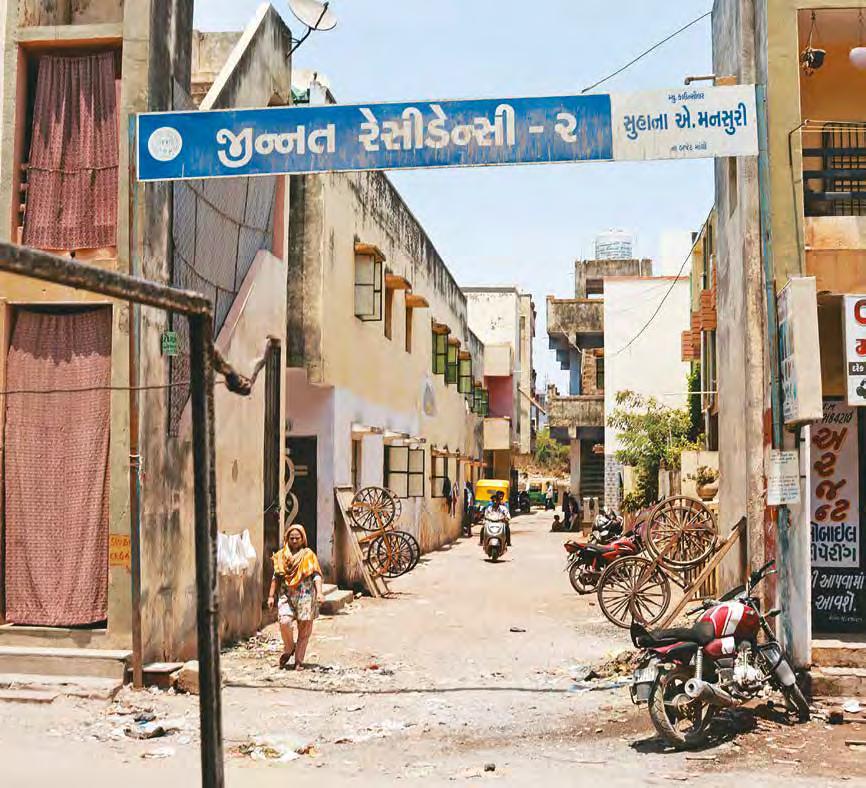
THE vast stretches of the main road of Sarkhej, Ahmedabad, become narrower, the buildings smaller and more congested as you take a detour and enter into what is known as India’s largest urban Muslim ghetto. Surrounded by settlements of the riot-hit minority community, the lanes lead up to a towering brick wall with fencing on top, built with the sole purpose of separating the Muslim population from its neighbouring Hindu colony, Vejalpur. This is Juhapura, an area located just a few kilometres away from the heart of Gujarat’s largest city, Ahmedabad. While it was founded as a rehabilitation project for the flood-hit victims in 1973, the area took a whole new meaning with a series of communal tensions over the next few decades.
The contrast here is stark: tall buildings lining up the Hindu colony, and waterlogged lanes, crumbling small houses and the poor economic conditions in the Muslim settlement. The streets of Juhapura are brimming with autorickshaws and cycles, lined on either side by meat shops, barber shops, mechanics and offices of travel and estate agents. It is usually at its busiest when the sun is up and shining. The bylanes open into multi-storeyed concrete structures stacked up like Lego blocks. Inside, the rooms are small and functional, housing a family of four or more and bearing the weight of an urban life amidst neglect and decay.
Shagufta Anjum, 38, lives on one of these lanes of Juhapura area. Early in the morning, as she prepares to get ready for the day, she calls out to her brother looking up to the corridor outside a cramped nine-by-nine room, “Switch off the pump. There has been no water since yesterday.”
“Today is jumma,” she turns to us and says. “But look, we don’t even have water to bathe. See how much the government is doing for us.”
This story is from the May 11, 2024 edition of Outlook.
Start your 7-day Magzter GOLD free trial to access thousands of curated premium stories, and 9,000+ magazines and newspapers.
Already a subscriber ? Sign In
This story is from the May 11, 2024 edition of Outlook.
Start your 7-day Magzter GOLD free trial to access thousands of curated premium stories, and 9,000+ magazines and newspapers.
Already a subscriber? Sign In

No Singular Self
Sudarshan Shetty's work questions the singularity of identity

Mass Killing
Genocide or not, stop the massacre of Palestinians

Passing on the Gavel
The higher judiciary must locate its own charter in the Constitution. There should not be any ambiguity

India Reads Korea
Books, comics and webtoons by Korean writers and creators-Indian enthusiasts welcome them all

The K-kraze
A chronology of how the Korean cultural wave(s) managed to sweep global audiences

Tapping Everyday Intimacies
Korean filmmaker Hong Sang-soo departs from his outsized national cinema with low-budget, chatty dramedies

Tooth and Nail
The influence of Korean cinema on Bollywood aesthetics isn't matched by engagement with its deeper themes as scene after scene of seemingly vacuous violence testify, shorn of their original context

Beyond Enemy Lines
The recent crop of films on North-South Korea relations reflects a deep-seated yearning for the reunification of Korea

Ramyeon Mogole?
How the Korean aesthetic took over the Indian market and mindspace

Old Ties, Modern Dreams
K-culture in Tamil Nadu is a very serious pursuit for many